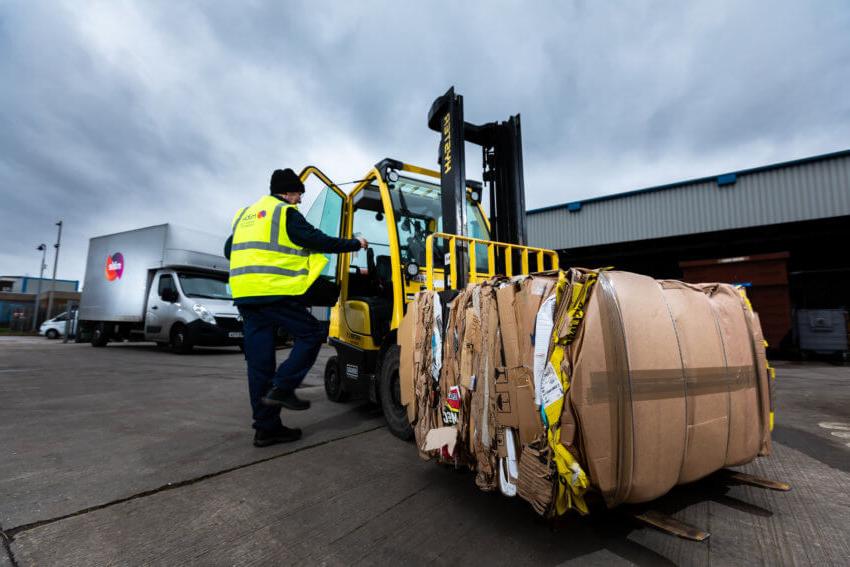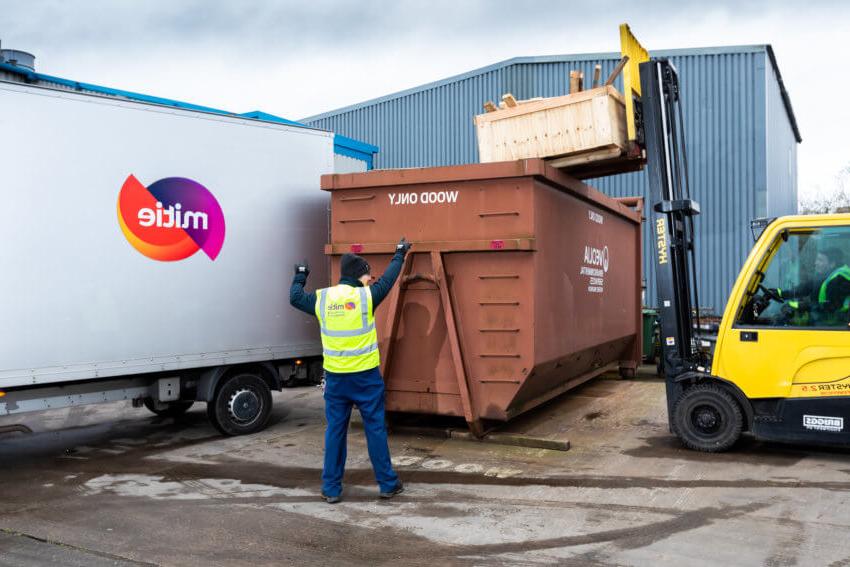精益生产中的浪费及如何减少
It wasn’t so long ago that the idea of lean manufacturing was the preserve of high-科技, 在日本有前瞻性的工厂. 但在一个制造商, 世界各地, 他们在追求效率和盈利能力方面不遗余力, 精益生产已经变得越来越普遍.
然而,精益生产的敌人是 浪费. 它可以由多种原因引起, 并可能对资产负债表产生重大影响, 交货期限和客户满意度, 都. 在本指南中, 我们将探讨精益生产中浪费的主要原因, 以及当它们发生时,Mitie如何帮助你处理它们.

什么是精益生产和精益生产浪费?
人们很容易把垃圾看作是扔进垃圾桶的物质, 但在制造业的背景下, 它的含义要广泛得多. 具体地说, it refers to any effort or expenditure that doesn’t contribute to the creation of a product that is ultimately bought by a customer.
A business that can eliminate 浪费 at every stage of its production process – from raw materials to the point of sale – is maximising its efficiency, 盈利能力和环境友好性.
可持续发展是Mitie的首要任务. 我们的废物管理专家 work closely with customers to help them reduce 浪费 and improve operational and labour efficiencies. 通过与他们的采购团队合作, we make sure that resources become part of the circular economy rather than going to landfill.
运用我们的废物管理方法, we helped a major aerospace customer to identify areas where manufacturing 浪费 could be reduced and efficiencies made. We conducted a ‘cradle-to-grave’ 浪费 mapping exercise across their 10 key UK sites and, 结果是, 3年多来,他们攒下了1英镑.600万美元用于废物管理成本.

精益生产中的主要浪费是什么?
精益生产中的浪费可能来自许多不同的来源, and here are some common areas that affect companies across the manufacturing sector:
运输
This doesn’t necessarily have to be related to the transport of materials or goods from site to site. However, poor logistical planning, or trucks that run below capacity, do generate fuel-related 浪费. 运输 can also be a generator of 浪费 within individual sites and factories. 例如, if adjacent parts of a manufacturing process are located at opposite ends of a factory, 更多的能量被用来移动物品. This also increases wear and tear on the vehicles used for the transport and generates higher labour costs as more staff are needed to operate the vehicles.
库存
当材料或货物储存的时间超过必要时, extra costs are generated due to the space and facilities needed to store them. 造成库存过剩的原因有很多, 比如生产过剩, 生产过程中的延迟, or excessive transportation where processes aren’t as efficient as they could be. The knock-on impact of poor inventory management can be seen directly in cash flow, 资产负债表指标和, 在最坏的情况下, 过时的产品.
运动
任何移动的东西都是有成本的, 无论是车辆的机械运动, 在传送带上, 或员工举起和搬运物品的人类运动. This means that any movement that isn’t kept to the lowest possible level counts as 浪费. 这可能是由于糟糕的建筑布局造成的, 设计糟糕的流程, 缺乏集成的未连接的系统和孤立的操作.
等待
“时间就是金钱”这句老话在制造业尤其正确. 任何在周围等待的东西——货物, 设备, 人们在烧钱的同时却没有做任何有成效的事情. 这种浪费很容易升级. 如果生产过程匆忙,以弥补失去的时间, 错误是可以犯的, 可以偷工减料, 缺陷慢慢出现,使货物卖不出去. 不良的过程控制, 可怜的通信, unplanned downtime and issues in the supply chain can all cause waiting-related 浪费.

生产过剩
This doesn’t mean making too many goods: it refers to one stage of a production process completing the task before the next stage is ready to start. 这将导致流程中的某些点出现不必要的阻塞, 降低了生产的整体速度,增加了存储需求. 不可靠的流程, 供应商管理不善, wrong forecasting and a lack of clarity in production schedules or customer expectations, 在这种情况下都会产生废物吗.
对加工
对加工 is where there are certain elements of a production process that simply don’t need to be there. 很明显, 这些额外的任务往往是整个过程的一部分, 像文件, 而不是在实际的产品制造中. 没有正确地映射过程, 误解顾客的需求, 以及沟通不畅或人为失误, 这些都会导致过度处理吗.
缺陷
在制造过程中存在许多缺陷风险. 例如, 制造中的错误, 质量控制中的错误, 不必要的库存波动, 可怜的设计, 以及糟糕的工作流程规划. 缺陷需要时间和金钱来修复, 哪一个能迅速对其他区域的顺利运行产生影响, 包括客户满意度, 声誉损失, 并最终, 产品需求.
三个简单的步骤就可以开始减少浪费
你的企业正在努力解决的任何类型的浪费, there is a simple three-step process that can help you discover the right way to reduce or eliminate it:
- 识别和评估
Conduct a thorough audit into the source of the 浪费 and any processes and activities connected to it. This should help you work out whether there is anything unnecessary that you can get rid of. - 删除和改进
当你拿掉你不需要的东西, 寻找方法来改进和优化那些必要的事情. - 重复
不断回顾调整后的流程, to minimise 浪费 and keep manufacturing running as lean and efficiently as possible.

通过Mitie为您的精益生产废物管理提供支持
Mitie takes a ‘resource not 浪费’ approach which prioritises 浪费 avoidance and minimisation through 以可持续发展为导向的“预防、减少、再利用和再循环”方法:
- 防止
减少不必要的商品和澳博官方网站消费. Consider the supply chain and, where possible, reduce the volume, mass, or toxicity. - 减少
如果不能防止浪费,我们会考虑如何在这个过程中减少浪费. 例如, by using fewer virgin materials, reducing 能源 consumption, or reducing its toxicity. - 重用
寻找在内部或跨站点重复使用材料的方法. Examining the role of packaging and modifying to enable less use, without impacting performance. 探索具有成本效益的, 道德, and environmental disposal routes where necessary from our own resource platform, 浪费匹配. - 回收
If we can’t help you prevent, reduce or reuse 浪费, we’ll help you find the best way to recycle. 回收可以产生更节能的材料, 污染更少,生产成本更高, 同时避免了原始材料的消耗. 法律合规, eco-credentials and over 30 years of experience mean that we typically achieve more than 90% recycle rates within 12 months.
使用我们的方法, 加上上述废物管理技术, Mitie is delivering on the promise to help lean manufacturing drive out inefficiency and make cost and sustainability savings.
联系团队 to discover more about how Mitie can help your business reduce your 浪费 in lean manufacturing.
读下
Mitie通过回收项目从垃圾填埋场节省了80吨制服
Mitie saves 80 tonnes of uniform from landfill with innovative recycling project

FM和可持续性之间的联系是什么?
Pradyumna V. 潘迪特, MD of Sustainability and Energy Services at Mitie gives his insight on the link between FM and sustainability. “作为一个经常在幕后工作的部门,世界FM日……

米蒂在“绿色影响”比赛中获得三枚金牌
Our Mitie Communities colleagues has won three awards in this year’s NUS Green Impact competition for contributing to sustainability at University College London Hospital (UCLH). 什么是环保影响? 绿色影响是一项联合国获奖方案,旨在……